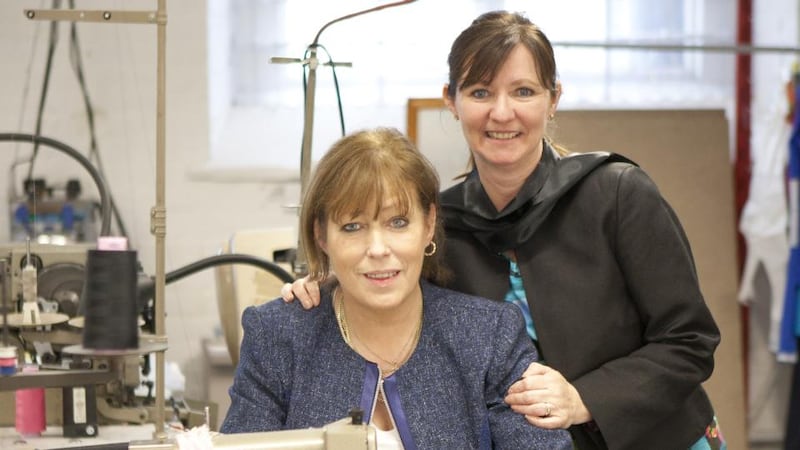S inead Clarke sits at her knitting machine framed by a forest of colourful knitwear. Hanging on rails or stacked on shelves, most of these scarves, bandanas, shawls and ponchos are destined for Japan and Canada, as well as shops at home.
Cavan-born Clarke, a fashion graduate from Limerick School of Art & Design, was the first Irish student to win the Mittelmoda award for Knitwear Designer of the Year in Italy in 2006, beating 1,500 competitors from all over the world. Part of her prize was a three-month internship with Missoni, the Italian fashion company in Milan, an experience which copperfastened her ambition to work in knit.
Now she produces her own EssenC label from her base in Fashion Hothouse in the former Greenmount Mills in Harold's Cross. This historic brick and granite building, whose connection with fashion and textiles dates back to 1799, houses facilities for up-and-coming fashion designers such as Clarke. Here, designs and sketches are measured, cut and made up for toiles (mock ups of garments), patterns executed, alterations carried out and special items made to commission. Three elaborate evening gowns were recently made here for the VIP Style awards, for example.


Nearby, on a huge cutting table, Paddy Rogers, who ran his own factory for years is wielding his shears into an elaborately patterned kaftan on a mannequin for the designer Helen Steele who is becoming increasingly successful internationally. Rogers started as a tailor in Dublin in 1956 and became a top cutter and pattern designer in Dublin's heyday as a thriving fashion industry centre. He remembers "learning about vents" and working with models such as Grace O'Shaughnessy and Suzanne McDougal. He now cuts for many designers.
At the next table, Breda Andrews, floor manager, demonstrates the considerable skills in her neat, elegant hands, masterminding sewing techniques like babylocking, flat machining, thread overlocking and gathering as she completes an elaborate organza bolero for a client with Pauline Smithers, principal seamstress.
Andrews started her career “slipping out threads off jeans” in a factory at the age of 14; “hated it”, then bought a sewing machine and worked from home making everything from Irish dancing costumes to debs dresses and at one time supervised wedding dress alterations for Hickeys. She also had her own sewing school and now has plans to start another in the Hothouse.
Andrews, Rogers and Smithers are just three of the team bringing their life skills and experience to new challenges, an idea that began with Peter Love, who originally moved into the building in 2003 after a period studying in Australia. From Terenure, Love studied engineering, then audio visual media and marketing in DIT before setting off to the Antipodes. After a stint in Sydney studying politics and economics, and a brief but unsuccessful venture into TV production for expats, he returned to Dublin and set up a photographic studio in the then vacant Greenmount Mills.
The venture into fashion came about almost by accident when he photographed a collection for a designer having problems with her production base in Poland. "There were a couple of sewing machines here and I thought if I could find someone to work them I could save this girl a lot of hassle (in Poland).
I had little or no experience of fashion, but I felt there was a need for such a sampling facility for young or aspiring designers who could not afford their own sample workshop. People said I was crazy, but perhaps it takes an outsider to be crazy enough to do this”, he shrugs.
His initial idea, to set up a fashion incubator unit, failed because young designers wouldn’t or couldn’t afford to pay for the space, so his business model changed. Now half the business of Fashion Hothouse is making custom designed garments that have been specially commissioned. The other 40 per cent is developing sample collections for up and coming as well as established designers “and everybody in between”. He is also developing an in-house collection helped by LSAD intern Brenda Long, which has just been launched online, called makeandtailor.com. Upstairs, his visual production facility with spacious photographic studios and video equipment is being used to promote the site.
Love admits that Fashion Hothouse is still finding its feet, but bringing those with long experience in the fashion industry together with young hopefuls is itself an important connection to make, particularly at a time when there is growing interest in designing and making at home.
"There are so many people qualifying every year in Ireland from some kind of fashion course, technical or third level and being thrown on the scrapheap and either heading abroad or going into whatever jobs there are in retail. You can be great on design, but if you can't work an accounts package or write good marketing or sales copy, then all the design skills will be useless because you can't bring a product to market to generate a career. It's not like being a mechanic. There are so many things that can go wrong for young designers," he says.
Designer Laura Jane Halton, who launched her own label two years ago, says she finds the facility fantastic. "I work in Maynooth and my clothes are made to order. It's good to have peers to connect with and great for designers to get samples made of upcoming collections. I am too busy to do everything, so this means I can work on my commissions in my own studio and get samples ready here." Others, like Peter O'Brien and Claire Doyle have also sampled here. As Love says, it's still an experiment, but with Limerick School of Art & Design to set up a fashion incubator unit next year, Dublin's fashion hothouse could be the start of a trend.













